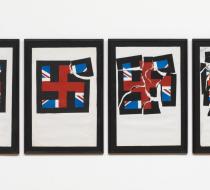Destruction of the National Front Favorite
TATE:
Destruction of the National Front by the artist Eddie Chambers is a collage on four panels depicting the deconstruction of an image of the Union flag shaped as a swastika. For the first panel in the sequence, the artist tore up an image of the Union Jack and reorganised it into the form of a swastika. Across the four panels, moving from left to right, the image becomes increasingly torn, with the final panel consisting only of scattered pieces, no longer recognisable as either an image of the flag or the swastika.
Chambers made the work while studying for a foundation course at Coventry Lanchester Polytechnic, shortly after Margaret Thatcher came to power as the Prime Minister of Britain in May 1979. Thatcher’s standing in the polls rose by eleven per cent after a television interview in January 1978 for World in Action in which she claimed that she ‘understood the fears of the British people of being swamped by coloured immigrants’. The political campaign saw the awakening of xenophobic sentiments in some sectors of the population and the rapid rise of the National Front, which reached the peak of its popularity in the 1979 General Election. Chambers has recalled:
When the work was made, the National Front had a very strong presence and the streets of Wolverhampton, where I grew up, were festooned with NF stickers declaring ‘If They’re Black, Send Them Back!’ … With such casual, but insistent and explicit ‘in-your-face’ racism, came a range of concerted strategies of combating and resisting that racism [such as] The Anti-Nazi League, Rock Against Racism, etc. It was in this context that my piece was conceived and made. All the students, all the people who saw [the work], could immediately grasp its references. Such was the presence of the NF at the time.
(Email correspondence between the artist and with Tate curator Carmen Juliá, 14 November 2012.)
Destruction of the National Front is a direct response to the appropriation of a national flag by a racist nationalist ideology. In the work Chambers made use of the disruptive connotations of collage and montage to undo the association of the nation with fascism. The destruction of the flag registers its use as a central image of the National Front and the failure of the sequence to result in cohesion acknowledges the painful truth of the racism in Britain. This work should be seen in the context of the years of protest marches, petitions, sit downs and burn-outs, as Black and Asian areas of British cities cried out against unacceptable conditions, racist violence and policing. Historian Jean Fisher has pointed out in her essay titled ‘The Other Story and the Past Imperfect’ how this particular work has come to exemplify the failure of modernism to represent the black subject (Fisher 2009, accessed 9 September 2015).
At Lanchester Polytechnic, Chambers met Keith Piper and together they formed the Wolverhampton Black Artists Group. In 1981 they organised their first exhibition under the title Black Art An’ Done at Wolverhampton Art Gallery. The group was later renamed as the BLK Art Group and expanded to include Donald Rodney, Claudette Johnson and others; together they produced a mutating exhibition under the title Pan-Afrikan Connection that toured Britain between 1982 and 1984. Chambers’s outlook, and that of many of the artists associated with him, drew much of its critical force from the shifts in emphasis within the American civil rights and Black Power movements of the 1970s – corollaries of which did not at that time exist in Britain or, at the very least, were not apparent. ‘As Black artists’, Chambers has recalled, ‘we were under obligation to make work which unreservedly aligned itself with the struggle of Black people: we fought against racism in our work, and sought to enhance and be part of a distinctly “Black” culture and its political identity.’ (Eddie Chambers, Run Through the Jungle: Selected Writings by Eddie Chambers, London 1999, p.57.)






